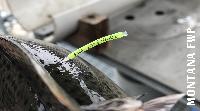Trout in the Clark Fork River are once again climbing the tallest fish ladder in Montana, according to a news release from Montana Fish, Wildlife and Parks.
Fish navigate 48 vertical feet through the ladder from March until October. In the first month of operation this year there have been documented ascents of 50 rainbow trout, five westslope cutthroat trout and two brown trout. About 380 ascend the later each year.
The fish ladder is part of the Thompson Falls Hydroelectric Project and is owned by Nortwestern Energy. The ladder is co-operated with Montana FWP. Since the fish ladder began operation in 2011 16 bull trout have managed passage into the upper stretches of the Clark Fork River.
From the news release:
“This ladder was designed to benefit the native salmonids, primarily bull trout, but we also want to learn what contributions the ladder may have for recreational fisheries.” FWP Biologist Ryan Kreiner said.
Using Passive Integrated Transponder (PIT) tags, fisheries biologists are tracking the movements of trout to better understand spawning and traveling habits. Continuing in 2018, biologists are also inserting visible Floy Tags into all trout to obtain angler catch data. An estimated 35 percent of trout that ascend the Thompson Falls fish ladder enter the Thompson River and biologists are curious where the remaining 65 percent are traveling. One tagged rainbow trout has already been reported up the Flathead River.
Anglers who catch a trout with a Floy Tag are asked to please contact FWP to report the location. It is safe to consume fish with Floy Tags.
“We want anglers to help us figure out where these trout are going,” Kreiner said.
The Thompson Falls ladder was the nation’s first full-height fishway designed specifically to accommodate the passage of bull trout. The structure was built because Thompson Falls Dam was adversely affecting threatened bull trout and a fish ladder would reduce, but not eliminate, the impacts of the hydro project. The dam, commissioned in 1915, is the oldest and smallest of three on the Clark Fork River.

Montana FWP Photo